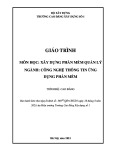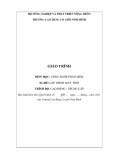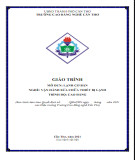
258 T. Seger, O. Hazzan, and R. Bar-Nahor
2 Research Background
2.1 Changes Introduced by Agile Software Development
The concept of “Agile development” emerged against the backdrop of the changing
global environment. Individual status has become superior to the system; clients have
become empowered and increasingly receive the full attention of service providers.
Furthermore, technological developments, economic prosperity and new cultural
trends have all created a new industrial environment that is centered on communica-
tions and information revolution [6].
In general, changes in the work environment are a kind of stress factor for employ-
ees [7]. In particular, moving to agile software development requires a change in the
software practitioners' mind set, which in turn might lead to even greater stress. Main
changes introduced by agile software development include: team empowerment, mov-
ing from a command and control structure to self-managed teams, applying very rigid
(although simple) guidelines that all must follow, using social pressure to align the
team members' behavior, accountability and taking responsibility, openness to criti-
cism, willingness to share knowledge and expertise, willingness to admit to failures,
seeking improvements, and goals orientation – willingness to do what ever is needed
(testing, development, design, documentation, etc.) in order to meet the objectives.
2.2 Coping with Changes and Threats in the Work Environment
Folkman and Lazarus [7] defined coping as a factor that mediates between the stress
experienced by the individual and the individual’s performance. In order to cope and
function more effectively when experiencing change, the individual mobilizes, or is
affected by, individual personality attributes (for example, self-efficacy in this study),
in addition to environmental resources (team climate components, in this study).
Researchers who studied the effects of organizational climate on employees found
that a positive managerial climate in the work environment is an empowering and
facilitating factor for employees (for example, [4, 11]). Thomsen, Soares, Nolan,
Dallender and Arnetz [12] compared the effect on employee performance of environ-
mental resources, such as managerial thoughtfulness, team collaboration etc. on the
one hand, and individual personality attributes on the other hand. They found that the
effect of environmental resources on employees was at least as strong as the effect of
individual attributes. In the present study we examine both aspects.
3 Research Model
Based on previous findings described in Section 2, Figure 1 presents a schematic
description of the research model examined in this study.
The dependent variable in the present study is the practitioner’s readiness for agile
software development; the independent variables are team-management climate and
individual personality attributes, focusing at this stage only on individual self-efficacy.
In what follows we describe the research hypotheses.

How Does Readiness for Agile Development Relate to Team Climate 259
Practitioners'
Readiness for Agile
Development
Team/Management
Climate
Level of
Individual
Self-Efficacy
Fig. 1. Proposed model for software practitioners' readiness for agile development
3.1 Team-Management Climate
The first hypothesis is based on findings that posit a relationship between positive
team climate, empowering managerial style and employee performance. Gillen, Baltz,
Gassel, Kirsch and Vaccaro [8] found a positive correlation between positive depart-
mental climate perceptions and employee performance, and coping with stress and
pressure at work. As mentioned, moving to agile software development emphasizes
both the need for team cooperation and the dependencies between team members.
Accordingly, the following hypothesis was formulated:
Hypothesis 1: Negative correlations will be found between perceived positive team
climate indices and the level of rejection of agile development; in other words, per-
ceived positive climate relates to a high level of readiness for agile development.
3.2 Individual Self-efficacy
The second hypothesis relates to individual self-efficacy, which is defined as an indi-
vidual characteristic that distinguishes between individuals according to their ten-
dency to perceive hard events as challenging and to perceive themselves as capable of
accomplishing almost anything [2, 3]. Accordingly, the following hypothesis was
formulated:
Hypothesis 2: Software practitioners with high levels of self-efficacy will exhibit high
levels of readiness for agile software development perceptions.
4 Research Methods
Questionnaires are being distributed to several hundred male and female software
practitioners. The questionnaire includes the participants’ demographic information,
followed by three sections that correspond with the study topics, based on the ques-
tionnaires developed by Halpin and Croft [9], Chen and Eden [5] and Hazzan and
Dubinsky [10].

260 T. Seger, O. Hazzan, and R. Bar-Nahor
5 Conclusion
We are currently at the data-gathering stage. The updated status of research will be
presented at the conference. Among other contributions, we propose that the research
results will have broad implications for the management of agile initiatives. For ex-
ample, if a significant relationship between self-efficacy and readiness for agile soft-
ware development is found, technological/software organizations will be able to
measure applicants’ self-efficacy as part of the recruiting processes.
References
[1] Auer, K., Miller, R.: Extreme Programming: Taming the Resistance. Addison-Wesley,
London (2001)
[2] Bandura, A.: Self-efficacy mechanisms in human agency. American-Psychologist 37,
122–147 (1982)
[3] Bandura, A.: Self-efficacy: The Exercize of Control. W.H Freeman, New York (1997)
[4] Bradley, J.R., Carwright, S.: Social support, job stress, health and job satisfaction among
nurses in the United Kingdom. International Journal of Stress Management 93, 163–182
(2002)
[5] Chen, G., Eden, D.: General self-efficacy and self-esteem: Toward theoretical and em-
pirical distinction between correlated. Journal of Organizational Behavior 25, 375–395
(2004)
[6] Crook, K.S., Pakulski, J., Waters, M.: Post modernization: Change in Advanced Society.
Sage, London (1992)
[7] Folkman, S., Lazarus, R.S.: Coping as a mediator of emotion. Journal of Personality and
Social Psychology 54, 466–475 (1988)
[8] Gillen, M., Baltz, D., Gassel, M., Kirsch, L., Vaccaro, D.: Perceived safety climate, job
demands, and coworker support among union and un-union injured construction workers.
Journal of Safety Research 331, 33–51 (2002)
[9] Halpin, A.W., Croft, D.B.: The organizational climate of schools. Chicago: Midwest Ad-
ministration Center of the University of Chicago (1963)
[10] Hazzan, O., Dubinksy, Y.: Clashes between culture and software development methods:
The case of the Israeli hi-tech industry and Extreme Programming. In: Proceedings of the
Agile 2005 Conference, Denver, Colorado, pp. 59–69. IEEE computer society, Los
Alamitos (2005)
[11] Lok, P., Crawford, J.: Antecedents of organizational commitment and the mediating role
of job satisfaction. Journal of Managerial Psychology 168, 594–613 (2001)
[12] Thomsen, S., Soares, J., Nolan, P., Dallender, J., Arnetz, B.: Feelings of professional ful-
fillment and exhaustion in mental health personnel: The importance of organizational and
individual factors. Psychotherapy and Psychosomatics 683, 157–164 (1999)

G. Concas et al. (Eds.): XP 2007, LNCS 4536, pp. 261–265, 2007.
© Springer-Verlag Berlin Heidelberg 2007
Communication Flow in Open Source Projects: An
Analysis of Developers' Mailing Lists
Selene Uras1, Giulio Concas1, Manuela Lisci, Michele Marchesi1, and Sandro Pinna1
DIEE Department of Electrical and Electronic Engineering
Universita' di Cagliari, Piazza d'Armi 1,
Cagliari, 09123, Italy
1
{s.uras,concas,michele,pinnasandro}@diee.unica.it,
manuelalisci@gmail.com
http://agile.diee.unica.it
Abstract. Team work is defined by different factors: team size, members role,
interactions and communication. In Agile Methodologies communication plays
a fundamental role. Some research studies have found that the involvement of
team members in a project also depends on the information provided. Commu-
nication also depends on the tool employed. The aim of this paper is to analyze
communication among team members of the 9 most active projects on Source-
forge provided of a developers' mailing list. In particular we tried to investigate
how and why members post to developers' mailing list and the use that different
members make of these mailing lists.
Keywords: Communication flow, social network, Open Source.
1 Introduction
Team work is defined by different factors: team size, member skills, member roles,
interactions and communication. Some researchers [5] have found that the team
member performance also depends on the information given on the project: better
knowledge corresponds to greater involvement.
In XP teams, communication is also a value and it can change in accordance with
team displacement. Communication is maximized in co-located teams but sometimes
a team has to work in a dislocated manner, as in Open Source teams [1] [2].
In the latter case, there are different tools for facilitating on line communication
such as chats, instant messengers, forums, wikis and mailing lists. In OS projects a
specific tool is often used: the developers' mailing list.
This tool is used like a (virtual) space in which developers can exchange ideas and
share information about project development. The aim of this work is to investigate
communication in Open Source communities. The attention was focused on the big
stage where actors-community members communicate: the developers' mailing list.
The aim of this work is to identify and evaluate the utilization of developers' mail-
ing list of mainstream Open Source projects, to get insight on communication patterns
among developers and the users of the list.

262 S. Uras et al.
2 Data Collection
This analysis is focused on nine projects chosen among the most active on Source-
forge website.1
We examined more than 70 projects in order to find a sufficient number of
projects.
In fact, when we looked for developers' mailing lists, we found that most of these
projects had none.
This can be easily explained considering the kind of use software development
teams make of Sourceforge [4]. Many teams started to use Sourceforge at the begin-
ning of their projects, but later, as the project size rapidly increased, they preferred to
use their own website with specific tools (CMS, wikies, forums...) in place of Source-
forge. At the same time, a large amount of these projects uses Sourceforge website as
a means for making their product better and more widely known So, it is very likely
that they use a developers' mailing list not available on Sourceforge web site.
Only 9 projects out of 70 seem to actually use Sourceforge developers' mailing list.
These projects are shown in Table 1.
Table 1. The nine projects studied. All have activity level at 99.90%
Project Topic Number of
analysed mails
Arianne Multi player on line engine to develop games 1159
Gaim Instant messaging application 8954
Gallery Web based photo gallery 3997
Geotools Open source java GIS toolkit 11076
Gimp-Print Package of printer drivers 7816
Licq Instant messaging application 4715
Mingw Tool for importing libraries and header files 2690
Miranda Instant messenger application 1045
Netatalk Daemon for sharing files and printers 4678
In order to investigate the developers' mailing lists chosen we implemented a spe-
cific parser that enabled automatic data analysis.
The parser was written in Java. It was created to extract key data from the reposi-
tory of a developers' mailing list.
For each e-mail, we extract the sender, the subject and the time, and for each thread
the ID of the starter. Different queries can be made to query the repository.
3 Data Analysis
First of all, it is interesting to point out that two subgroups participate in discussions
in developers' mailing list: the sub-group of users and the sub-group of developers.
Preliminary, we checked and resolved e-mail addresses and user names: about
50\% of community members (both developers and users) use different user names
1 All the data reported are extracted from www.sourceforge.net
























![Bài giảng Tổ chức - Cấu trúc Máy tính II Đại học Công nghệ Thông tin (2022) [Mới Nhất]](https://cdn.tailieu.vn/images/document/thumbnail/2025/20250515/hoatrongguong03/135x160/8531747304537.jpg)

